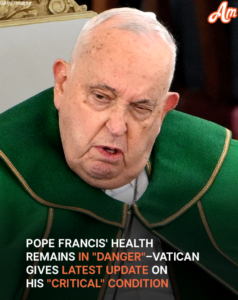Pope Francis, aged 88, has been hospitalized since February 14, 2025, at Rome’s Gemelli Hospital due to a severe respiratory infection. The Vatican has provided regular updates on his condition, indicating that while he remains in critical status, there have been moments of slight improvement.
Initial Hospitalization and Diagnosis
The Pope was admitted after experiencing breathing difficulties, and subsequent medical evaluations diagnosed him with bilateral pneumonia and asthmatic bronchitis. These conditions necessitated intensive antibiotic treatments and continuous medical supervision. Given his medical history, including a partial lung removal during his youth due to pleurisy, his susceptibility to respiratory ailments has been a significant concern.
Current Health Status
Recent reports from the Vatican have described Pope Francis’s condition as critical but stable. He has experienced episodes of respiratory distress, including a prolonged asthmatic crisis that required the administration of high-flow oxygen. Additionally, blood tests revealed thrombocytopenia, indicating low platelet counts, which led to blood transfusions to address associated anemia. Despite these challenges, the Pope has remained conscious and alert, engaging in limited activities such as sitting in an armchair and consuming meals. However, his prognosis remains guarded due to the complexity of his health issues.
Medical Interventions and Concerns
The medical team has been vigilant about potential complications, particularly the risk of sepsis, a severe bloodstream infection that can lead to organ failure. While there have been no signs of sepsis, the Pope’s advanced age and existing health conditions necessitate cautious monitoring. His treatment regimen includes cortisone, antibiotics, and supplemental oxygen to manage the lung infection and prevent further deterioration.
Speculations and Vatican Response
The Pope’s health crisis has sparked discussions regarding the potential for resignation, reminiscent of Pope Benedict XVI’s resignation in 2013. However, Vatican officials have dismissed these speculations, emphasizing that Pope Francis remains in control and continues to fulfill his duties as much as his health permits. The Vatican has also highlighted the absence of clear guidelines for leadership transitions in cases where a Pope becomes incapacitated but does not resign or pass away, underscoring the unique nature of the current situation.
Public and Clerical Support
The global Catholic community has been actively praying for the Pope’s recovery. Masses and prayer vigils have been held worldwide, reflecting the deep concern and affection for the pontiff. Within the Vatican, daily operations continue under the guidance of senior officials, ensuring that the Church’s functions persist uninterrupted during this period of uncertainty.
Outlook
While there have been slight improvements in Pope Francis’s condition, his health remains fragile. The medical team continues to provide comprehensive care, aiming to stabilize his condition further. The situation remains dynamic, with the Vatican committed to offering timely updates as developments occur. The Pope’s resilience and the support from the global community play crucial roles as he navigates this challenging period.
